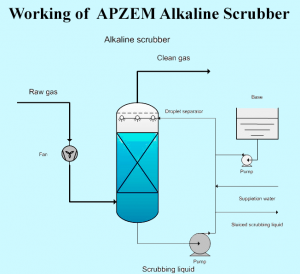Alkaline Scrubber
Product Description
In an alkaline scrubber, acid-forming components are collected via neutralization using a base as scrubbing liquid. This leads to the formation of salts, which can eventually be reprocessed. The drained water is purified and discharged into the sewer network.
Alkaline dosage occurs on the basis of pH control. The pH for an alkaline scrubber is normally kept between 8.5 and 9.5. The pH cannot be set very high, due to increased alkaline usage at higher pHs due to absorption of CO2 in the water. From a pH above 10, the dissolved CO2 will be present in the water as carbonate, whereby alkaline use will increase sharply. The calcium carbonate will also precipitate on the packing, whereby the pressure drop will increase. To avoid this, softened water must be used for alkaline scrubbers.
Technical Specification
- Air Flow: upto 70,000 CFM
- Efficiency : upto 99.99% capturing efficiency
- MOC: Mild Steel / SS 304 / SS316 / FRP / PP / PVC
- Finish: Powder coated / Matt finish
- Power option : 3 Phase.
- Customization : Yes , customization available suiting your needs.
Contaminants Removed
- HCl
- HF
- SO2
- Cr2O7
- Cl2
- Phenols
- Organic acids
- H2S
Applications
Is used for the removal of acid-forming components during incineration processes in:
- Electricity plants
- Waste combustion installations;
- Electro industry
- Chemicals industry
- Chlorine production
Advantage
- Relatively compact;
- Very high removal yields
- Can be constructed in modules, multi-stage systems
Other Technical Details
- Contaminant solubility
- Vapor pressures
- Wash liquid flow rate
- Liquid to gas ratio
- Packing chamber height, diameter, and volume
- Packing media type and size
- Chemical additives
- pH control
- Precipitation of reaction products
- Multiple solution scrubbing
- Required scrubbing stages
- Pressure drop across packing
- Materials of construction
- Site requirements
- Centrifugal Blower,
- Spiral Ducts,
- Flexible duct,
- Suction hoods,
- Magnahelic gauge,
- Packings
- PH meter
- Water Level indicator & controller
- Pump etc..
Certification : All Apzem Products are designed to comply with ACGIH and OSHA standards as well as local PCB Standards.
Warranty : All Apzem Products are minimum one year waranted for performance and quality.

